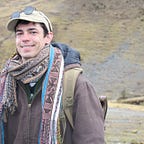The Magic Mushrooms of Lamas, Tarapoto, Peru
In the cloud-covered hills above Tarapoto, the pueblo of Lamas sits on a ridge overlooking a fertile valley. The farms, or chacras, in the area produce a bounty of tropical plants including coffee, cacao, coconut, sugarcane and other fruits and spices you’ve likely never heard of — but what’s special about this particular place is another, magical crop… mushrooms.
Psilocybe mushrooms can be found all over the world in any warm, wet area where the dung of hooved animals can be found (so it’s always worth a look if you’re in a place with these conditions). Psilocybe cubensis grows in profusion in the mist-covered livestock fields around Lamas, where constantly alternating sunlight and rain create an ideal environment for the mushrooms to spring from the Earth.
The Psilocybe cubensis mushroom almost certainly arrived in Lamas with the introduction of cattle into the high jungles area, but other species of psychoactive fungi may have existed in the region before it. Nothing indicates, however, that the ancient people of this area used psychoactive mushrooms.
Los “Kallamperos”
People have come to this area for at least 25 years — perhaps longer — to collect mushrooms, but there is no evidence of traditional mushroom usage in this particular area (although in other parts of Peru, the use of mushrooms may have been more common).
Today, a limited number of young Peruvians around Tarapoto know where to pick and how to identify the magic mushrooms. Kallampa means mushroom in Quechua, and villagers sometimes give those who pick and use the mushrooms the nickname “Kallampero,” or “Mushroom Worker.”
The native people, who seem to know nothing of the use of the mushrooms in the past, now seem mildly intrigued with the curious drug that has been growing right under their noses, but of which they were largely unaware. And although ayahuasca is well known in this culture, some people in the village look down upon the use of mushrooms and have misconstrued concepts regarding it, thinking the mushrooms are smoked or having wild ideas of the fungi’s effects.
Most locals, however, have a genuine curiosity about the mushrooms, often stopping and having conversations with the mushroom hunters.
Beyond Fungi
If communing with magical fungi isn’t enough reason to visit Lamas, you’ll find plenty of other things to do in the area, including coffee and cacao tours, visiting waterfalls, ayahuasca ceremonies, cultural centers, small museums, traditional wares, native rituals and dances, and even fossil hunting.
Fossils of ammonite and other shelled creatures dot the local riverbeds; you can either collect your own with a guide or purchase polished fossils in Lamas. Many medicinal plants grow in the high jungle, and the natives know how to use almost all of them: oje, huito, ayahuasca, sacha ajo, chuchuwasi, coca and many more.
If archaeology is more your thing, you’ll find an ancient enigma just above the village of Pamashto, a short ride from Lamas. Here, a large stone circle, aligned to the rising sun on a certain day, sits atop a grassy hill. Nobody knows who built this structure; some say it may have been the Chancas or possibly the Chachapoyas, yet no one alive truly knows. You won’t find these ruins in any guide book and they are largely unknown even to the people in the area. They are also on private property. On June 21 — the Winter Solstice — a gathering is held at the stone circle to watch the alignment of the rising. Ask for permission to visit and you might be invited to join the festivities.
The fertile land produces an abundance of crops but the main cash crops are sugar cane, coffee, cacao and musk hibiscus (Abelmoschus moschatus). Tours of these farms can be arranged, which may include demonstrations of harvesting and processing as well as tastings of the products made from these plants (the coffee here is superb).
The cañazo (fermented and distilled sugar cane alcohol) will burn your throat and give you one hell of a buzz — and it costs about the same as bottled water, two soles for half a liter. The cacao is some of the best in the world and is exported to every corner of the globe in the finest of chocolates.
This beautiful location is less than an hour from Tarapoto but feels a world away from the hustle and bustle of the city. The quiet hills are a nice place to relax and take a break after a ceremony or trek.
Should you go to this area seeking magic mushrooms, it’s best to go with a local guide. Remember to always be respectful of the people, their land, their cattle and their property. Always ask for permission before wandering off the road into a field and offer the owner a small tip or donation for allowing you to use the field. If you go without a guide then make sure your Spanish is good, and keep in mind that the landowner may be hard to find.
Good luck, and keep huntin’.
Written by Scott Lite from EthnoCO. Edited by Tony Dunnell.
Originally published on Tarapoto Life- http://tarapotolife.com/2016/01/07/the-magic-mushrooms-of-lamas-in-san-martin-peru/
